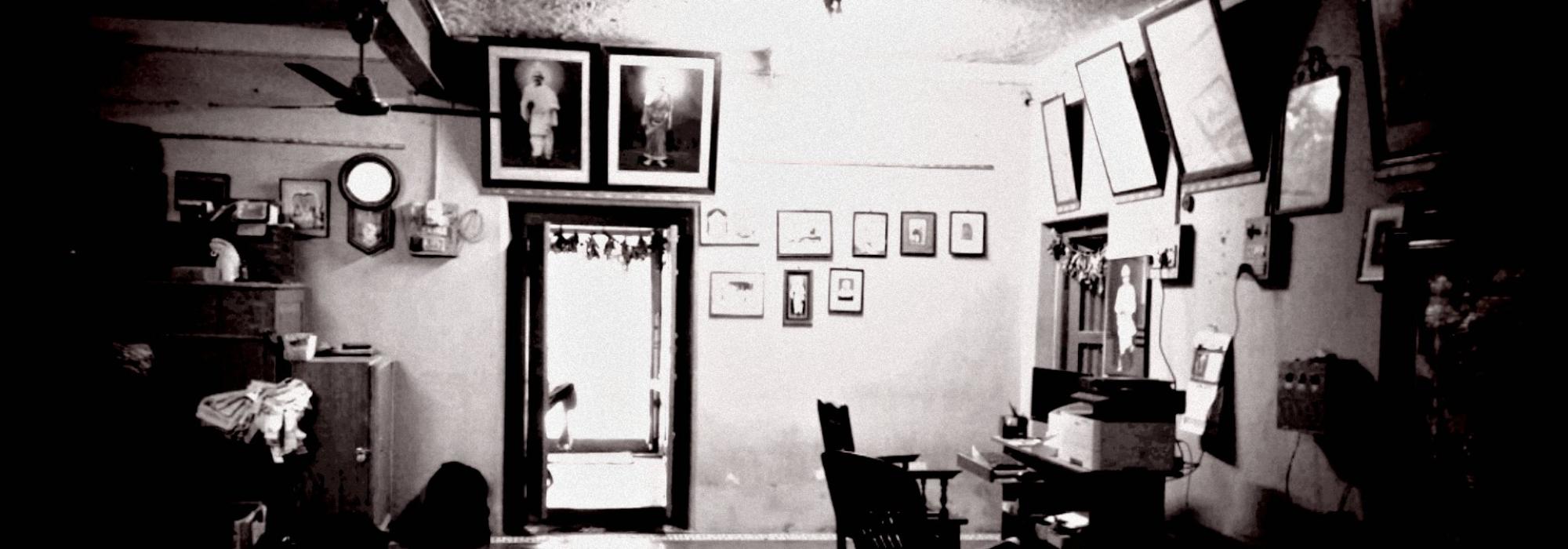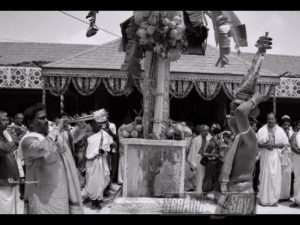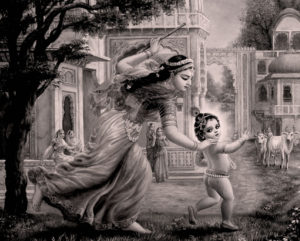‘Gruhabhanga’ is one of Bhyrappa’s profound yet simple and sad stories, set in the background of rural Karnataka. The novel presents the rites, rituals, witchcraft, village deities, and the beliefs of the villagers. Usually, the deity of the village is called ‘Ooramma’, or the mother of the village, and it is believed that she protects the village from epidemics like the plague, cholera and small pox. People belonging to all strata of society worship this deity, both individually and collectively. The ritual, that is typical of one type of witchcraft is described as follows:
Kanti Jois rides on his white horse in the night. His son-in-law, Chennigaraya, a coward and an effeminate person, follows Kanti Jois in the forest. A light is seen on the right side of the road and the horse stops there. Witchcraft was being practiced there through the worship of the idol of the deity Kali. The idol was waist high. its blood red tongue had emerged out of the open mouth and it looked like it was licking blood. There was a big garland of red oleander hanging down to the earth around the idol. Mud lamps burnt on both sides. Three hens were lying there, their heads cut off. The two halves of ash gourd and three bunches of bananas were present and kumkum was scattered abundantly. Haldi and kumkum (Turmeric and vermilion) were smeared on the body of Kali. An unspun thread, a sheet of copper, amulets, bones of human beings and animals scattered around, money placed on the chest of the idol - all these added to the fear. Kanti Jois ordered his son-in-law to bring the money that was on the chest of the idol along with the bananas. When the son-in-law was unable to do it out of sheer fear, Kanti Jois takes all the money that was placed on the idol, and kicks the idol in the chest with his shoe-clad foot. The mud idol breaks and a gold coin falls down along with the idol.
The novel describes these rituals of witchcraft, as well as the rituals of dispelling the effects of witchcraft. But the courageous person that Kanti Jois was, he remains unaffected by any kind of witchcraft, as he was well versed with black magic as well as the righteous, more pious way of worship. In many places, we still witness the prevalence of these rituals.
Proclamations by “Goode Marammanavaru" about the advent of epidemics like the plague etc., is another custom that used to be prevalent in the villages of Hassan district and other places. A priest donning a strange costume represents the Goddess of the village, "Goode Maramma". He smears haldi and kumkum on his body and carries the basket of Goode Maramma on his head. The upper part of his body is bare and he is clad in colourful attire, and beats himself repeatedly with a jute rope that is as thick as a man's arm, and one and half meters long. His wife who follows him predicts the evil that the deity might cause. This ritual, described in "Gruhabhanga", is seen even today in villages and towns. In this context of ‘Goode Maramma’, there is one point that should be noted: as soon as a mouse falls dead in any house in the village, Goode Maramma warns of impending calamity and the people leave their houses, and build huts on the outskirts of the village or town. After the plague subsides, they return to their homes.
Though the Goode Maramma ritual seems to be a superstition, the warning, the knowledge of the link between the death of the mouse and plague shows that these rituals might have had a meaningful, scientific basis at one time. Another popular observance that is prevalent even today is the habit of writing ‘Come tomorrow’ on the front door of the house, as if to mislead the evil spirit. During the time of the plague, many people used to feel that a woman had thrown her large dark pallu on them, and it is believed that it is none other than ‘Plague Maramma’. Many people used to succumb to the fear of plague, rather than the disease itself. Kalamma is the goddess of the village Rampura. The goddess had to be placated by every family in the village, with offerings of rice boiled with jaggery, curd rice, coconut fruit, flowers and blouse pieces. Worship of the snake god, and the associated rites and rituals are described in detail in ‘Gruhabhanga’.
This is an evolving cult and a growing myth, as even today the sincere faith and belief accompany this form of worship and the rituals associated with it. Ant-hills, which are believed to house snakes, are worshiped; milk is poured into the burrows on ant hills, believing that the snake god would drink it, though this is not be true. Generally, the snake god is worshiped with devotion, austerity and with a pure body and mind. In this novel, it is said that this ceremony had to be performed on the sixth day of a fortnight. When the people of Rampura suffer from skin diseases like scabies, people like Gangamma remember this worship of the snake god, which is called ‘Nagara maduvudu’. Cobras are the species of snakes that are worshiped.
The rituals are like this: Everyone in the family goes out into the garden on a chosen ‘shasthi’ (sixth day of the fortnight). The men of the household are expected to have dug a small well in the garden the previous day itself. The women of the household bathe and purify themselves and prepare special food items namely, payasam, obbattus, vadas (uraddal), rice, rasam and sambar using fresh water from the newly dug well. The cooking of these items is done outdoors, in the garden itself. A widow, a widower, a bachelor, two priests and their wives are invited for lunch along with the other members of the house. A likeness of the snake god is fashioned out of dough made by mixing wheat flour and rice flour and worshiped. Lunch is served as generously as on the day of the Shraaddha ceremony (rituals of the death anniversary).
After lunch, ‘dakshina’ or gifts of at least one silver coin should be given, along with a two-layered dhoti for the men, and cloth for a blouse for women. Single-layered dhoti and a single holy thread (yajñopavītam) should be given to the bachelor who has been invited. The members of the household partake of the food as ‘prasadam’ after these ceremonies. In the evening ‘mahamaṅgalārati’ is performed. Then the image of the snake god is taken to the same well, and immersed in it along with the remaining wheat flour, rice etc. and the well is then closed. Everyone returns home without looking back. This type of worship of the snake god is not common, though some of the rituals are still observed on the day of ‘shasthi’ in many homes. The cobra is considered to be an alternate form of the deity Subrahmanya. There are many myths associated with snakes.
In the novel 'Gruhabhanga', Gangamma performs these rites and rituals by begging to collect the material needed. Nanjamma and her children, too, suffer from scabies. But they are cured through proper injections administered at the government hospital. Thus, though the rites and rituals of snake worship are elaborately described, the author shows the impact of scientific awakening too. Myths, rituals, superstitions, rational thinking, and scientific approach to issues are all presented simultaneously.
Madevayya represents the lndian sadhus, jangamas (wandering saint) and sanyasis, who are always a part of age-old Indian culture and tradition.
A legend from mythology that is popular in folk culture of Karnataka, is used to show that the grief of a mother who loses her child is the same across all ages. Secondly, this myth also brings the sufferer face to face with the stark reality that the past and the present are entirely different. According to the myth, the child Kṛṣṇa returns to his mother, the Gopi, but Nanjamma’s children Parvathi and Ramanna can never return. Here, the mother has to live with the loss of her children. Overwhelmed by the death of her children, Nanjamma is haunted by the question, ‘Why do children die before the eyes of mothers?’ Then Madevayya narrates this story of Kṛṣṇa’s childhood. Kṛṣṇa, when he was a little boy, was testing his mother Yashoda in many ways. When he fasted, Yashoda, too would fast, she would not drink milk until Kṛṣṇa did. One day Kṛṣṇa asked his mother: ‘Mother, what will you do if I die?’
‘O my child, am I going to live without you? I too will die,’ she replies.
‘Truly?’ Kṛṣṇa asked. ‘l swear on your life, you my child,’ she says.
One day, Kṛṣṇa slipped into the pond. He shouted, ‘Mother, pull me out, come into the water, save me, l am dying!’ Kṛṣṇa was drowning. Yashoda stood on the bank and shouted, ‘Some body please come and save my child’. But nobody came. Yashoda threw a part of her sari to the child to hold on. But it did not reach Kṛṣṇa. Kṛṣṇa cried again, ‘Mother, mother’, drowned and died. Yashoda sat there and wept, but did not jump into the pond or end her life. On the third day Kṛṣṇa came out of the water and asked Yashoda, ‘Mother, is this all the love you have for me? - Even when l actually died, you did not die. Here after, may children die before the eyes of their mothers!’And to this day, children die prematurely like this because of Kṛṣṇa’s curse.
Unlike Yashoda of the legend, Nanjamma wants to end her life She steps courageously into the pond, but the thought of Vishwa prevents her from dying. (Pg. 307-309, ‘Gruhabhanga’). This popular story from mythology very effectively picturises the grief of the mother from yore, and in the present age, and bridges the gap. At the same time, it also presents the harsh reality of the present and brings out the difference between the past and the present. There is no relief now from any divine force. The dead husband cannot come back, the dead children cannot live again.
Along with Vedic myth, the novel ‘Daatu’ consists of many legends which have mythical and folklorish elements in them. The legend of the ash-gourd that is used in ‘Daatu’ takes us back to the Tretayuga, to the reign of King Bharatha (Pp. 50-53, ‘Daatu’). The story is narrated by the minister Melagirigowda to Lankegowda (characters in the novel), while canvassing for the elections. This story very poignantly shows how every group uses mythology and mythological characters to its own advantage, and how the facts of mythology are twisted, turned and even distorted completely at times.
It is said that, when Rama returned to Ayodhya after an exile of fourteen years in the forest, there was no money in Ayodhya for the coronation ceremony of Rama, for Bharatha, being a kind and generous king, had not collected any taxes from the peasants. The minister Sumantha, who had not agreed with Bharata’s policy, now invented a crooked plan and shared it with Rama. Rama gave to each peasant one seed of the ash gourd plant, and told the peasants to grow it. And Rama would grow a weight equal to the weight of the ash-gourd. Failing which each of them would have to pay gold equal in weight to the weight of that ash-gourd. Else the peasants would be beheaded. The seeds that were given to the peasants did not sprout at all. They had to bring in the gold, and the minister did not stop until the peasants had brought in the 'taali' (maṅgala-sūtra) of their wives.
The minister Melegirigowda said that Rama had deliberately given the peasants fried seeds, so that they would not sprout. Chinnegowda, a Yakshagana scholar, contests this version of the story. He defends Rama saying that he did not give fried seeds, but the insolent farmers did not sow the seeds at all. Then, Anjaneya assumes the form of a fly and sits on the ash-gourd grown by Rama. When the balance did not move even when all the gold in the kingdom was used to balance it, Rama asked the farmers to bring the maṅgala-sūtra of their wives to balance the weight. Rama only went through this to teach the subjects a lesson.
Afterwards, he returned all the gold to the farmers and said that no farmer in his kingdom should ever have to shed tears. The inner meaning of the story narrated by the minister failed to reach the farmers who were assembled at the election meeting. One farmer, Shingegowda claims that these brahmins have concocted this story so that the ash gourds would be left for their sole consumption. This story of the ash-gourd is interpreted by the minister as an example of exploitation of farmers by brahmins. This story of an insignificant vegetable like the ash gourd connects the political and social situation of the distant past with the present political situation. This is an example that shows how mythologies, mythological characters and incidents are twisted in every age to the advantage of the people. Besides this, it also reveals how the mythical aspect of the past is rooted in the psyche of the common man in various forms.
To be continued....

















































